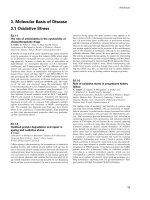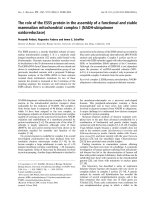Edited the role of the monarch in the political and cultural life of the uk
Bạn đang xem bản rút gọn của tài liệu. Xem và tải ngay bản đầy đủ của tài liệu tại đây (75.51 KB, 3 trang )
In the United Kingdom, monarchy is the oldest form of government.
The Head of State in a monarchy is a king or queen. The monarchy of the
United Kingdom is known as a constitutional monarchy. While the Sovereign
is the Head of State, an elected Parliament has the power to make and pass
legislation.
Monarchy of the United Kingdom
The United Kingdom's Monarchy, also known as the British Monarchy,
is a constitutional form of government. As the head of state of the United
Kingdom, Crown dependencies, and British Overseas Territories, a hereditary
sovereign reigns. Queen Elizabeth II is the current monarch, ascending the
throne in 1952.
The political role of the Monarch
The powers of the Monarch today
At first sight, the Crown can appear purely ceremonial and of little
consequence to the realities of government, politics and power. However, it
still holds real and significant capabilities, even if they are not exercised by
convention. Instead, a cabinet and its head – a prime minister, a premier, or a
chancellor – drawn from a legislature (Parliament) are in charge of
governmental duties. Therefore, the Queen reigns but does not rule in a
society deeply committed to the ideal of democracy.
The Queen stands as a factor of national unity and cohesion, especially
in times of crisis, such as natural disasters, conflicts, or terrorist attacks. And
the fact that the Queen does not interfere with political life is probably one of
the primary reasons the British are still attached to the Monarchy.
The future of Monarch
It could be argued that the Monarchy underpins an outdated class
system and gives the impression that Britain is a backward-looking nation.
However, looking to the future, most British are confident that the Royal
Family is here to stay. According to a 2015 YouGov poll, more than six in ten
(62%) believe Britain will still have a monarch in 100 years – a view that has
not changed dramatically since the Diamond Jubilee in 2012.
Role of Monarch in cultural life
From Annie Leibovitz to Lucian Freud to hologram creator Chris
Levine, Elizabeth II has sat for over 200 portraits. She never expresses an
opinion on the results, at least not publicly, and appears to consider lending
her time to artists to be part of her cultural responsibility.
Perhaps the most exciting evolution of the Queen's cultural impact can
be seen in the fashion industry. Her clothing choices never considered avantgarde or fashion-forward, can be most generously described as safe.
Because she cannot be underdressed under any circumstances, the
Queen will often wear a matching hat, coat, and gloves. This powerful
machine was considered the leading edge of frumpiness for a long time.
However, other women, particularly those in positions of prominence without
power, began to admire the Queen's highly coordinated, color-saturated look
over time. Michelle Obama favors bright colors and patterns (as evidenced by
the matching yellow dress and coat she wore to her husband's inaugural
parade, which was eerily similar to the Queen's usual attire).
All this must be very reassuring to a monarch in her twilight years. She
doesn't have to change to keep up with the times. If she stays as she is, the
times will get back to her.
REFERENCE
1. Castor, Helen (2010). Faber and Faber. She-Wolves: The
Women who Ruled England Before Elizabeth.
2. Emma.Goodey (2016-03-17). "Succession". The Royal Family.
Retrieved 2021-04-23.
3. Matthew, H. C. G. (2004). "Edward VIII (1894–1972)" and
"George VI (1895–1952)". Oxford Dictionary of National Biography.
Oxford University Press. Retrieved 14 October 2008 (subscription required).









